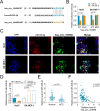circRNA hsa_circ_104566 Sponged miR-338-3p to Promote Hepatocellular Carcinoma Progression
- PMID: 33028110
- PMCID: PMC7784580
- DOI: 10.1177/0963689720963948
circRNA hsa_circ_104566 Sponged miR-338-3p to Promote Hepatocellular Carcinoma Progression
Retraction in
-
Retraction Notice.Cell Transplant. 2024 Jan-Dec;33:9636897241298459. doi: 10.1177/09636897241298459. Cell Transplant. 2024. PMID: 39601276 Free PMC article. No abstract available.
Abstract
Circular RNAs (circRNAs) could sponge micro-RNAs (miRNAs) to regulate tumor progression of hepatocellular carcinoma (HCC). Hsa_circ_104566 contributes to papillary thyroid carcinoma progression. However, the tumorigenic mechanism of hsa_circ_104566 on HCC remains enigmatic. The role of hsa_circ_104566 on HCC was therefore evaluated in this study. First, the high expression of hsa_circ_104566 was found in HCC tissues, which was significantly associated with poor prognosis in HCC patients. Second, Hsa_circ_104566 promoted HCC progression by decreasing apoptosis and E-cadherin, while increasing cell viability, proliferation, migration, invasion, and N-cadherin. On the other hand, HCC progression was suppressed by knockdown of hsa_circ_104566. Hsa_circ_104566 could target miR-338-3p, and its expression was negatively correlated with miR-338-3p in HCC patients. Moreover, miR-338-3p suppressed protein expression of Forkhead box protein 1 (FOXP1) and had a negative correlation with FOXP1 in HCC patients. Functional assay further indicated that the promotion of HCC progression by hsa_circ_104566 was reversed by miR-338-3p, and miR-338-3p inhibitor could counteract the effect of hsa_circ_104566 knockdown on the suppression of HCC progression. In vivo assay indicated that hsa_circ_104566 knockdown suppressed HCC tumor growth and metastasis. In conclusion, hsa_circ_104566 sponged miR-338-3p to promote HCC progression, providing a potential therapeutic target for cancer intervention.
Keywords: FOXP1; HCC; hsa_circ_104566; miR-338-3p; progression.
Conflict of interest statement
Figures







References
-
- Ruzic M, Pellicano R, Fabri M, Luzza F, Boccuto L, Brkic S, Abenavoli L. Hepatitis C virus-induced hepatocellular carcinoma: a narrative review. Panminerva Med. 2018;60(4):185–191. - PubMed
-
- Cao X, Quanlin A, Assaraf YG, Xiangdong W. Retinoids offer new and promising cancer therapeutic avenues. J Mol Clin Med. 2019;2(2):23–28.
Publication types
MeSH terms
Substances
LinkOut - more resources
Full Text Sources
Medical
Research Materials

